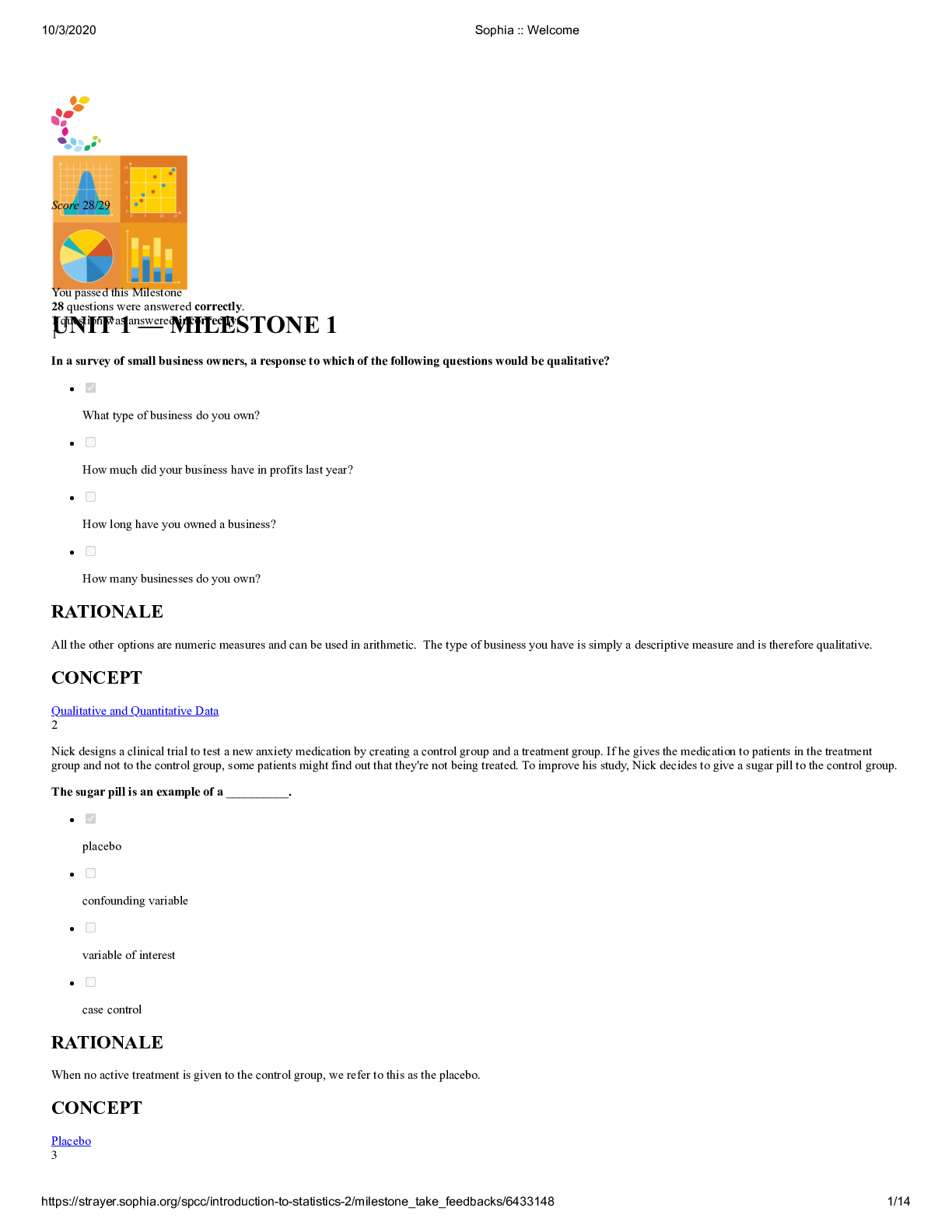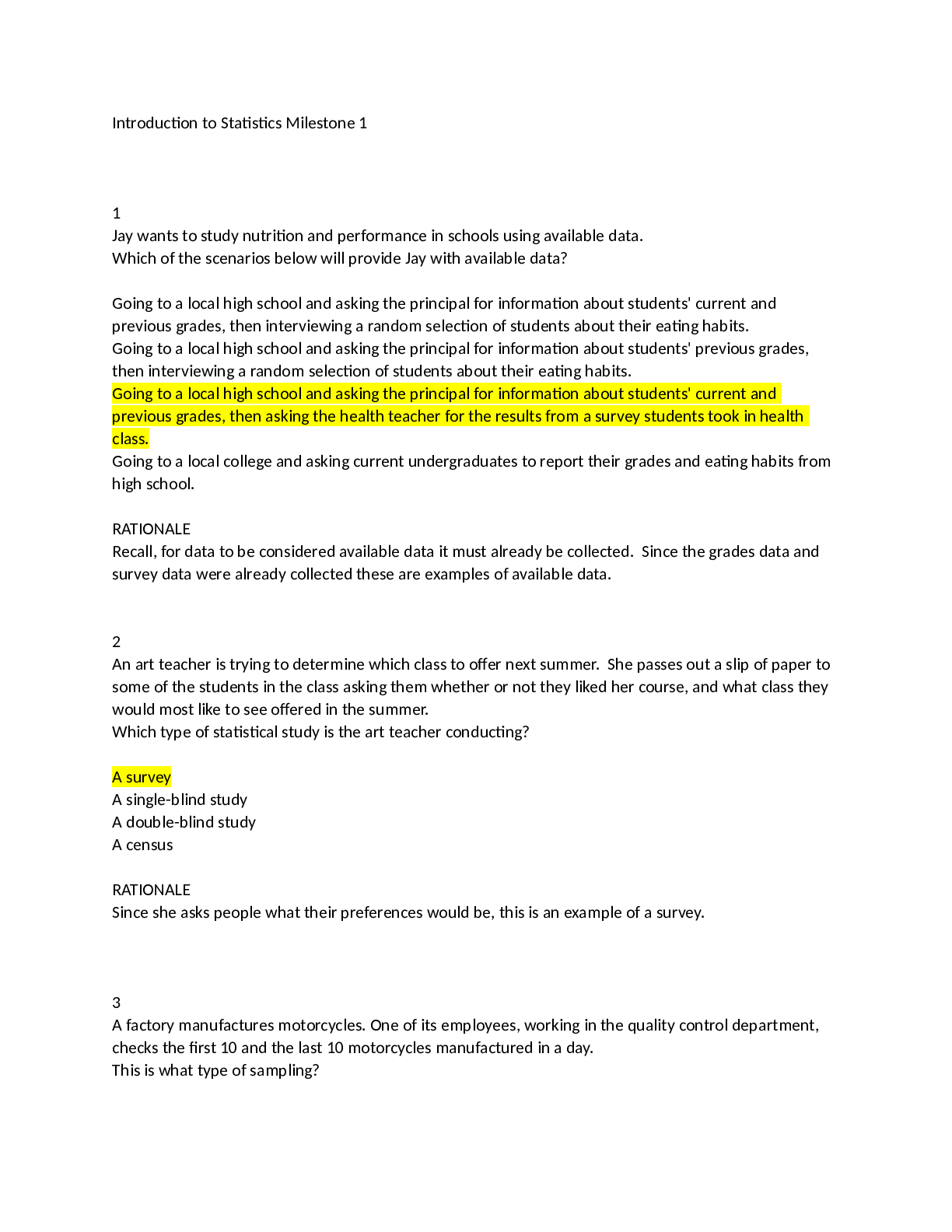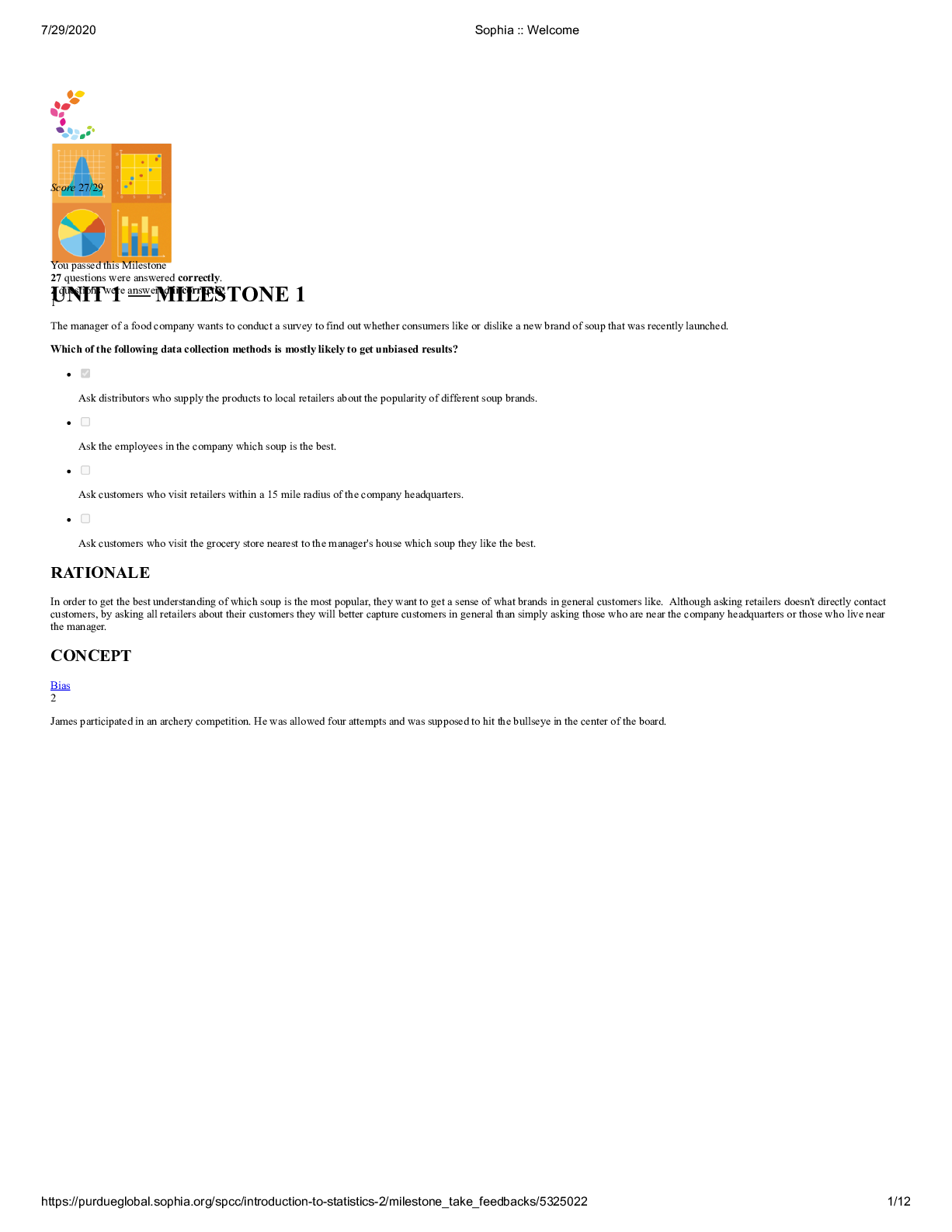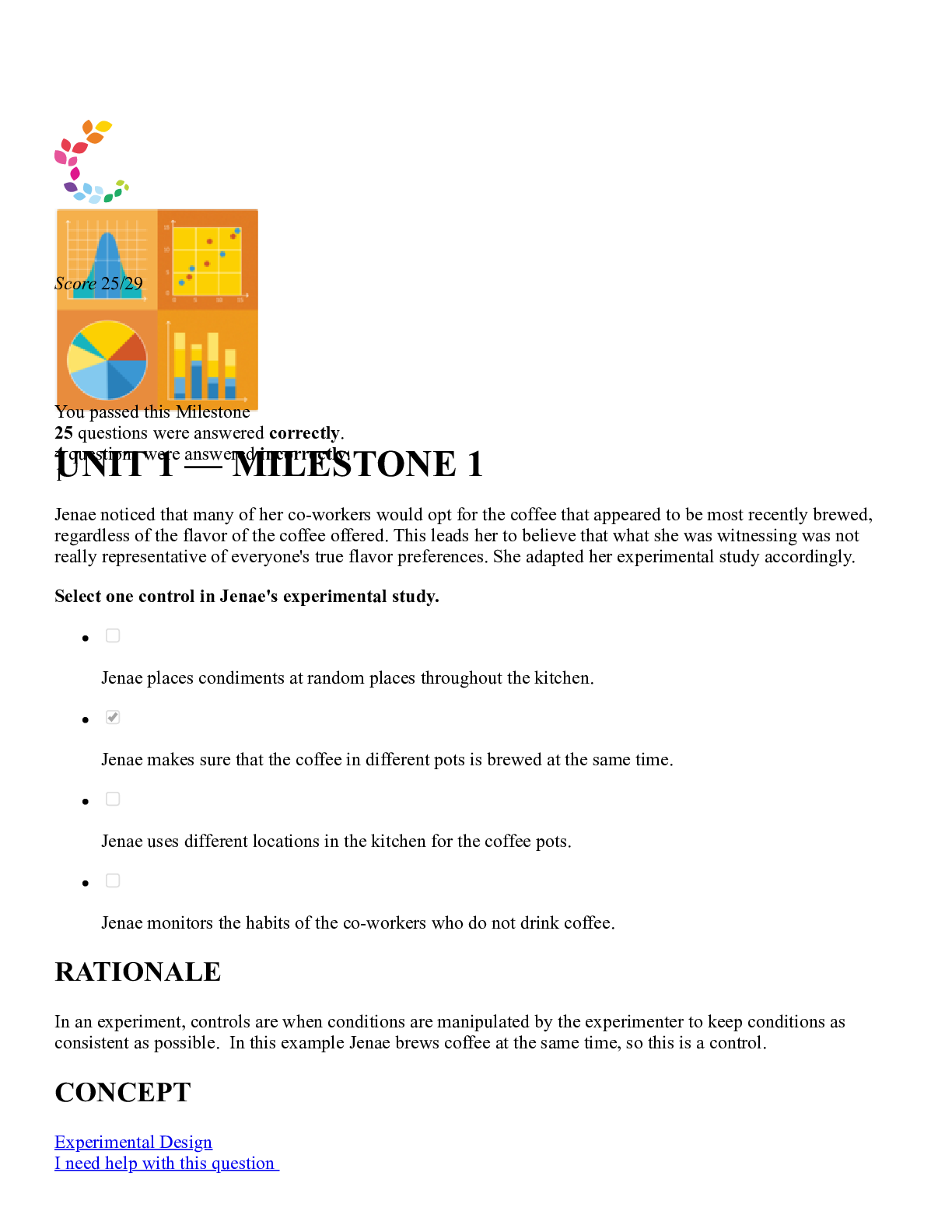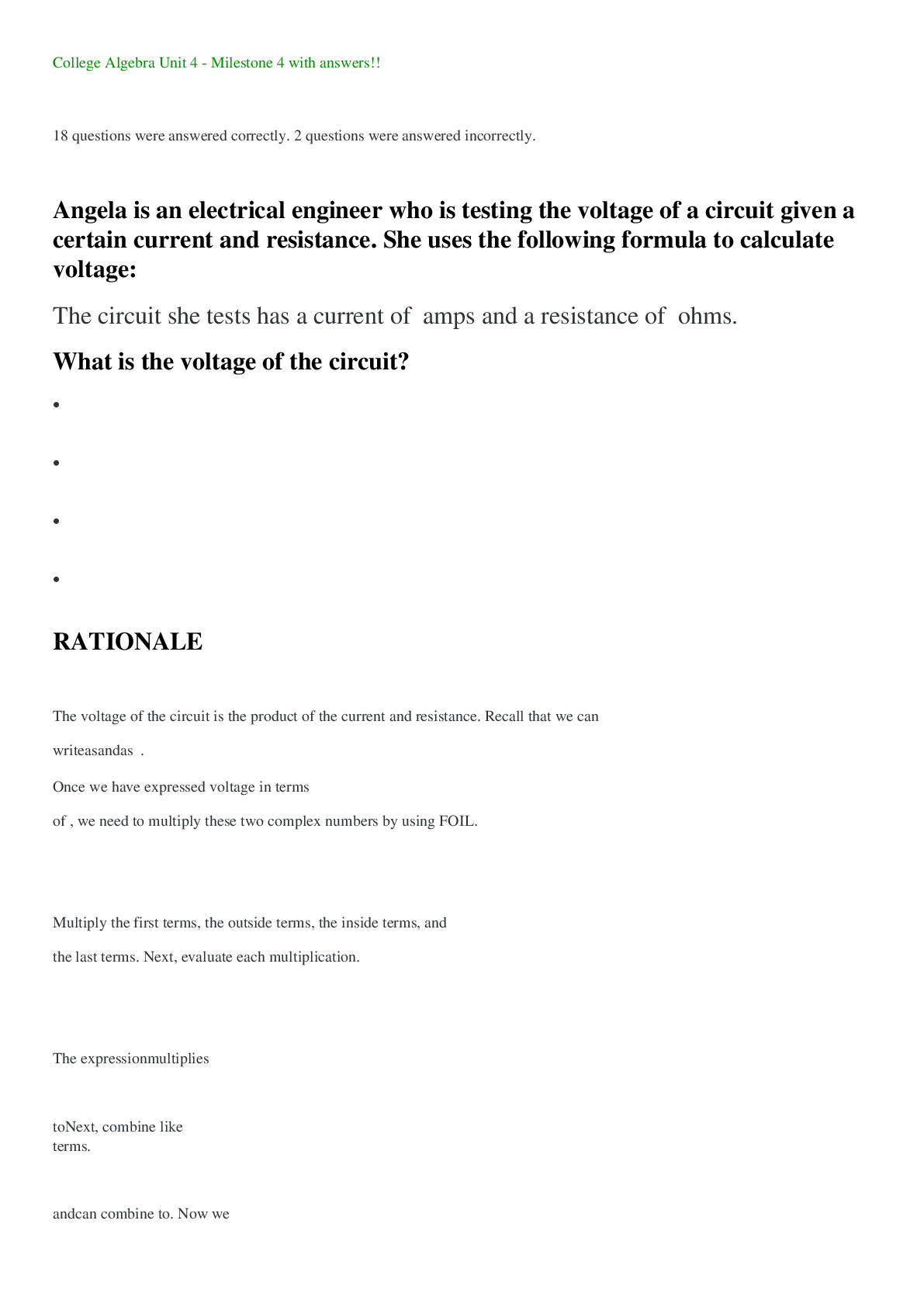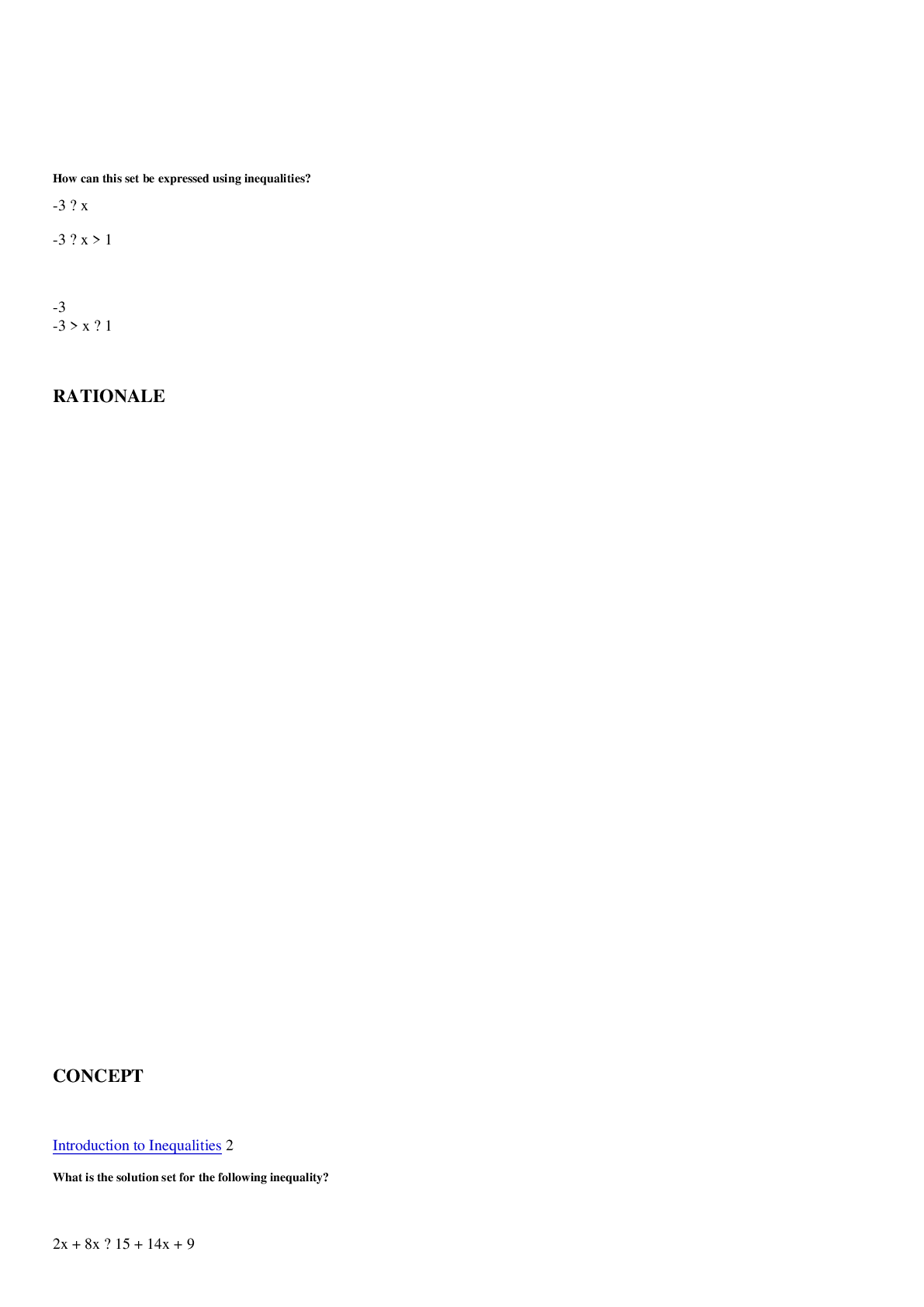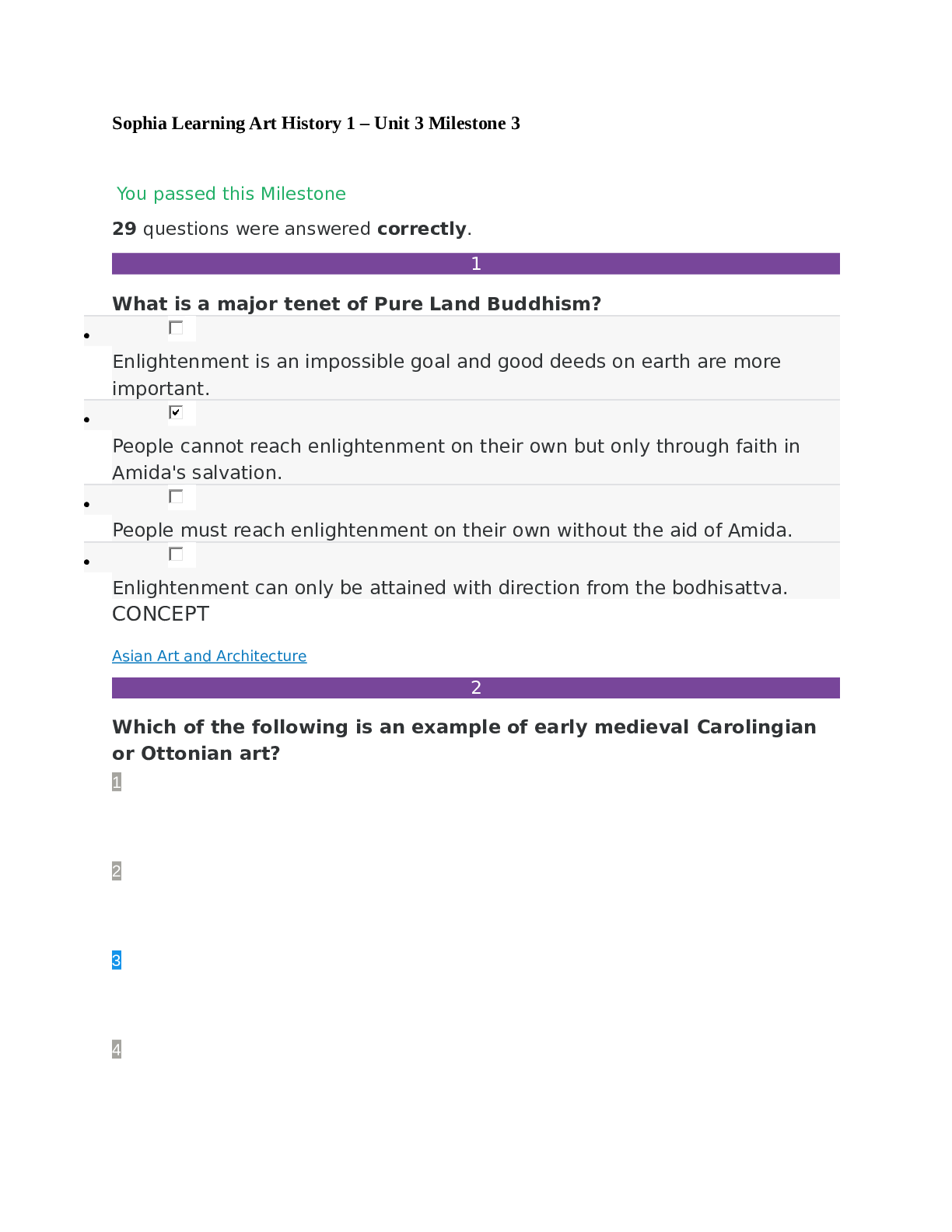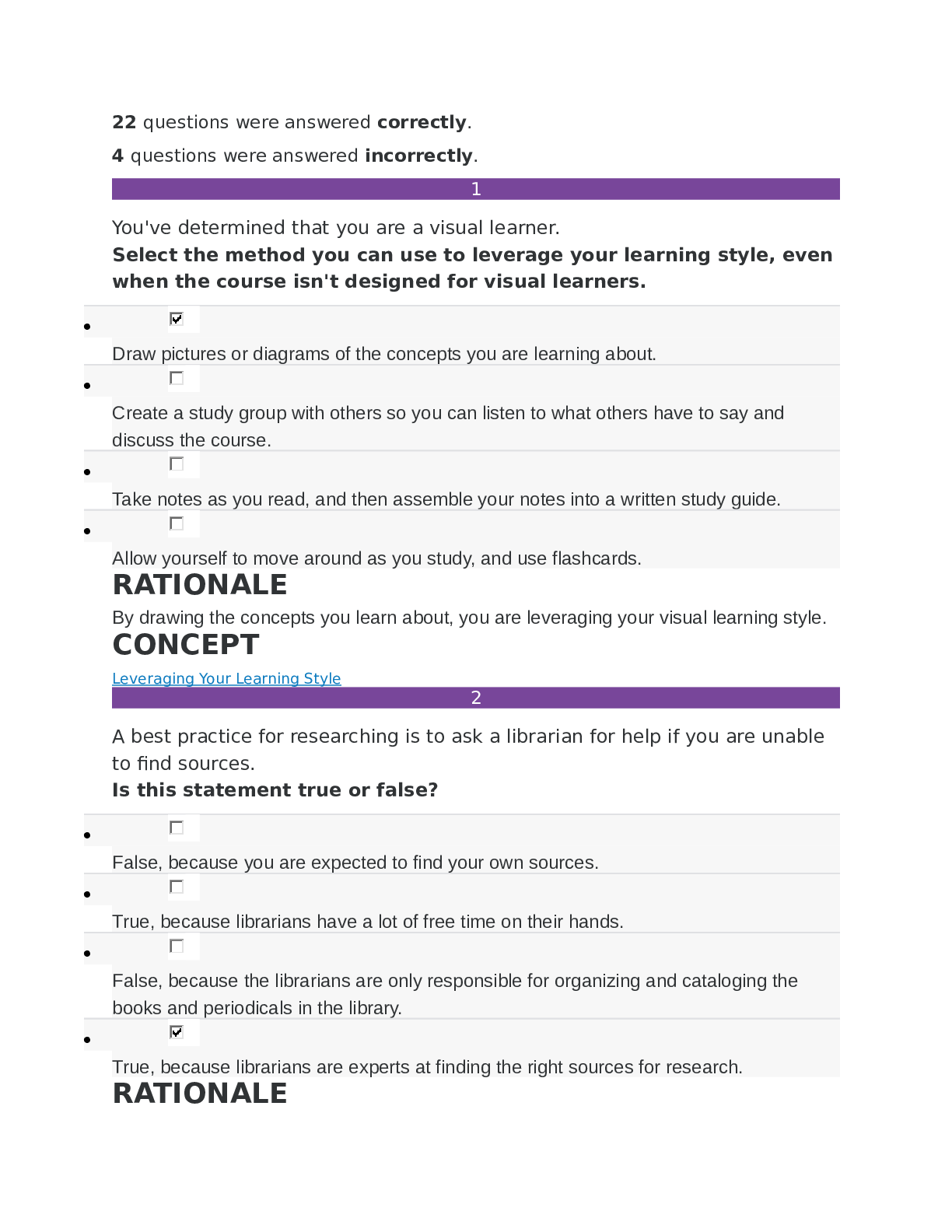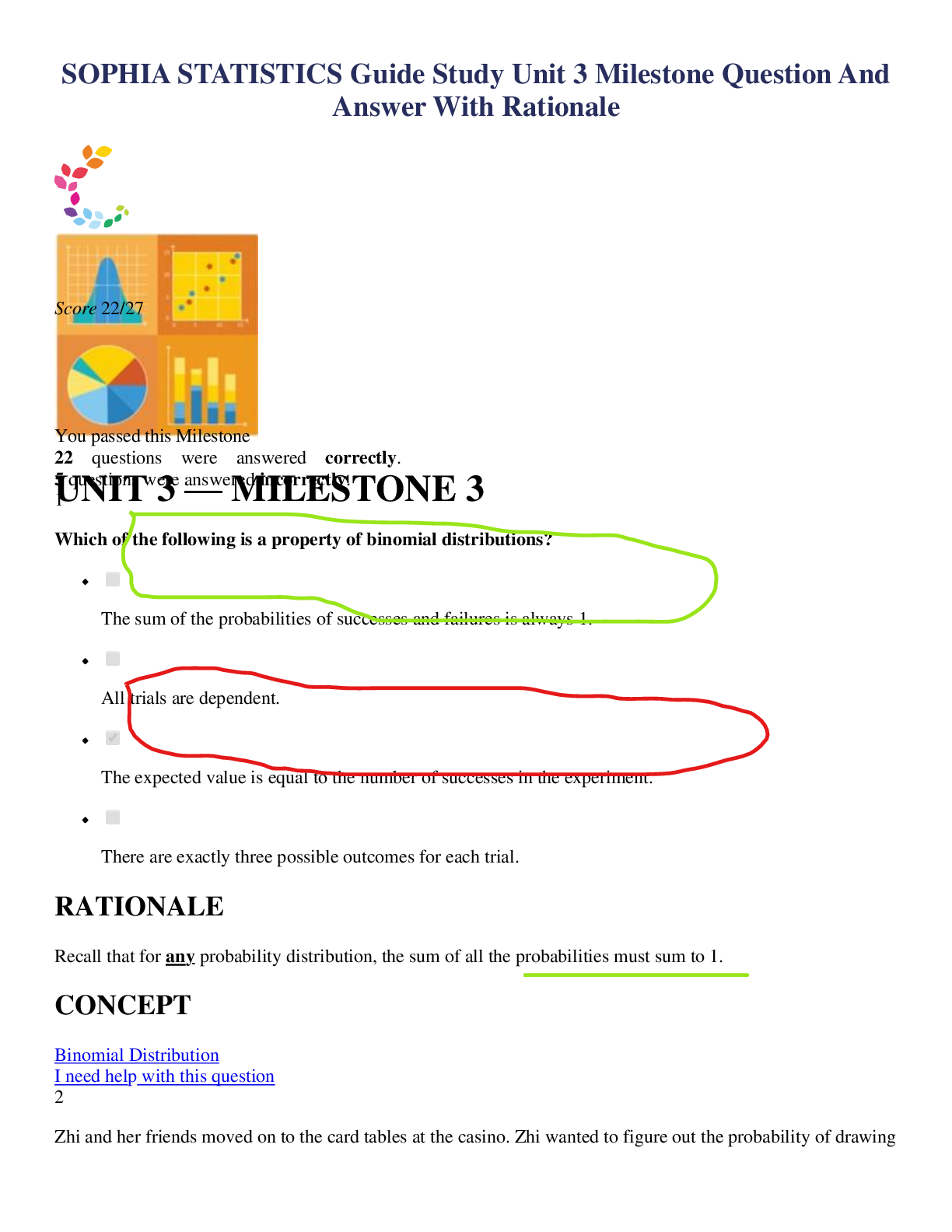*NURSING > SOPHIA Milestone > SOPHIA MILESTONE MATHEMATICS QUESTIONS WITH ACCURATE ANSWERS, GRADED A+ (All)
SOPHIA MILESTONE MATHEMATICS QUESTIONS WITH ACCURATE ANSWERS, GRADED A+
Document Content and Description Below
Susan monitors the number of strep infections reported in a certain neighborhood in a given week. The recent numbers are shown in this table: Week Number of People 0 20 1 26 2 34 3 44 According ... to her reports, the reported infections are growing at a rate of 30%. If the number of infections continues to grow exponentially, what will the number of infections be in week 10? 203 people 206 people 276 people 297 people 3/2/2021 Sophia :: Welcome https://snhu.sophia.org/spcc/college-algebra-3/milestone_take_feedbacks/8101034 2/28 RATIONALE In general, exponential growth is modeled using this equation. We will use information from the problem to find values to plug into this equation. The initial number of infections is , so this is the value for . The infection rate is , so this is our value for (remember to write it as a decimal). We want to know how many infections there will be in week 10, so we will use for the value for . We will need to solve for . Start by simplifying what's inside the parentheses. plus is . Next, take this value to the power of . to the power of is . Finally, multiply this by . There will be 276 people infected in week 10. CONCEPT Exponential Growth 2 Suppose and . Find the value of . RATIONALE To evaluate this composite function, focus on the innermost function first. Evaluate first by plugging in for the variable in the function . a b x y 1 x 3/2/2021 Sophia :: Welcome https://snhu.sophia.org/spcc/college-algebra-3/milestone_take_feedbacks/8101034 3/28 Once has been replaced with , evaluate the expression. The function evaluates to . To evaluate , use the value of , which is , as the input for the function . Once has been replaced with , evaluate the expression. This tells us that is equal to . CONCEPT Function of a Function 3 Write the following as a single rational expression. RATIONALE Just as with numeric fractions, we can re-write division of algebraic fractions as multiplication and multiply across numerators and denominators. To re-write fraction division as multiplication, re-write the second fraction as its reciprocal (flipping the numerator and denominator). changes to and division changes to multiplication. We can now multiply across the numerators and denominators. x f left parenthesis x right parenthesis x 3/2/2021 Sophia :: Welcome https://snhu.sophia.org/spcc/college-algebra-3/milestone_take_feedbacks/8101034 4/28 times is equal to and times is equal to . Next, find any common factors in the numerator and denominator. Both the numerator and denominator have a factor of . We can cancel out these factors and simplify. Once all common factors have been canceled out in the numerator and denominator, write the fraction in simplest form. This is the the simplified fraction written as a single rational expression. CONCEPT Multiplying and Dividing Rational Expressions 4 Suppose , , and . Find the value of the following expression. RATIONALE This question involves several properties of logarithms. The Quotient Property of Logs states that division inside a logarithm can be expressed as subtraction of individual logarithms. This means we can express as . Next, the Product x squared x 3/2/2021 Sophia :: Welcome https://snhu.sophia.org/spcc/college-algebra-3/milestone_take_feedbacks/8101034 5/28 Property of Logs states that multiplication inside a logarithm can be expressed as addition of individual logarithms. This means we can express as . Then, the Power Property of Logs states that exponents inside a logarithm can be expressed as outside scalar multiples of the logarithm. This means we can express as and as . Finally, we can substitute the values we were previously given for , , and . Recall that , , and . Once these given values are substituted into the expression, simplify each term and then perform the addition and subtraction. times is , and times is . Finally, add these values together. The logarithmic expression evaluates to . CONCEPT Applying Properties of Logarithms 5 Solve the following logarithmic equation. RATIONALE log subscript a left parenthesis x right parenthesis log subscript a left parenthesis y right parenthesis log subscript a left parenthesis z right parenthesis 3/2/2021 Sophia :: Welcome https://snhu.sophia.org/spcc/college-algebra-3/milestone_take_feedbacks/8101034 6/28 Logarithms and exponents are inverse operations. We can use the base of the logarithm, , as a base to an exponent, and place the logarithmic expression as an exponent in the equation. We'll have to do this to both sides of the equation. Here, we used as a base number on both sides of the equation. When we do this, the logarithm and exponent will cancel each other out. On the left side, the logarithm and exponent cancel each other out, leaving only . On the right side, is equal to . Finally, divide both sides by to solve for . The solution to the equation is . CONCEPT Solving Logarithmic Equations using Exponents 6 To collect data on the signal strengths in a neighborhood, Briana must drive from house to house and take readings. She has a graduate student, Henry, to assist her. Briana figures it would take her 12 hours to complete the task working alone, and that it would take Henry 18 hours if he completed the task by himself. How long will it take Briana and Henry to complete the task together? 5.6 hours 7.2 hours 6.7 hours 4.5 hours RATIONALE We can use the relationship between work, rate, and time to build equations to solve this problem. To begin, we need to identify the relationship for Briana and Henry, separately. Briana's rate is 1 task in 12 hours. We do not know the time it will take them to work on the project together, so we will just denote the time as . When we multiply the rate and time together, we get Briana's work at ( notice how the units of hours cancel). We can repeat this process for Henry. 10 x t 3/2/2021 Sophia :: Welcome https://snhu.sophia.org/spcc/college-algebra-3/milestone_take_feedbacks/8101034 7/28 Henry's rate is 1 task in 18 hours. We do not know the time it will take them to work on the project together, so we will just denote the time as . When we multiply the rate and time together, we get Henry's work at . Now we can create a rational equation by adding Briana and Henry's work together. The work is 1 task, so their combined work is equal to 1 task. In the rational equation, is the amount of time it takes Briana and Henry to complete the task together. With rational equations, we can add them together once they have common denominators. A simple way to find common denominators is to multiply the denominators of the fractions together. Make sure that you are doing this to all terms to ensure they all end up with the same denominator. Next, evaluate the multiplication. Now we have three fractions with common denominators. Once we have this, we can solve for using the expressions in the numerator. To solve for , first combine like terms. plus is equal to . Finally divide both sides by to solve for . It will take Briana and Henry 7.2 hours to complete the task together. CONCEPT Rational Equations Representing Work and Rate 7 Kevin examines the following data, which shows the balance in an investment account. Year Balance 1 $5,000.00 2 $5,100.00 3 $5,202.00 4 $5,306.04 5 $5,412.16 What is the formula for the geometric sequence represented by the data above? t t t t t 3/2/2021 Sophia :: Welcome https://snhu.sophia.org/spcc/college-algebra-3/milestone_take_feedbacks/8101034 8/28 RATIONALE This is the general formula for a geometric sequence. We will use information in the table to find values for and . Let's start with finding , the value of the first term. The first term, which is , so will be replaced by in the formula. Next, let's find , the common ratio. To find , take the value of any term, and divide it by the value of the previous term to find the common ratio. For example, so . Finally, plug in values for and into the geometric sequence formula. This is the formula for the geometric sequence. CONCEPT Introduction to Geometric Sequences 8 Simplify the rational expression by canceling common factors: a subscript 1 r a subscript 1 a subscript 1 r a subscript 1 r 3/2/2021 Sophia :: Welcome https://snhu.sophia.org/spcc/college-algebra-3/milestone_take_feedbacks/8101034 9/28 RATIONALE In order to cancel like terms, we have to first factor both the numerator and denominator, and then look for common factors in the top and bottom of the fraction. Let's take a look at the numerator first. To factor this quadratic, we need to identify a pair of integers whose product is the constant term ( ) and whose sum is the coefficient of the x-term ( ). Two integers that multiply to and add to are and . This means that and make up the integer pair for this quadratic. The original numerator can be written as . Let's take a look at the denominator. Again, we need to identify a pair of integers whose product is the constant term ( ) and whose sum is the coefficient of the x-term ( ). Two integers that multiply to and add to are and . This means that and make up the integer pair for this quadratic. The original denominator can be written as . Now we can rewrite the original fraction with the new factored numerator and denominator. The original fraction is now rewritten with both numerator and denominator written in factored form. To simplify, we cancel factors that appear in both the top and the bottom. The factor left parenthesis x plus 4 right parenthesis can be canceled. The rational expression can be simplified to . CONCEPT Simplifying Rational Expressions 9 Consider the function . Find the formula for the inverse function. 3/2/2021 Sophia :: Welcome https://snhu.sophia.org/spcc/college-algebra-3/milestone_take_feedbacks/8101034 10/28 RATIONALE To find the inverse of a function, you can write the function as , swap the variables and , and then rewrite the equation with on one side. First, start by swapping with . Here is the function written as an equation where . Next, we will swap the variables, and . Now that the variables are swapped, we will manipulate this equation to place on one side of the equation. We'll start by squaring both sides to undo the radical. When a square root is squared, the result is the expression under the radical. Next, we will subtract from both sides to undo the addition of . Multiply both sides by to undo the in front of . We have now isolated the variable to one side of [Show More]
Last updated: 3 years ago
Preview 1 out of 28 pages

Buy this document to get the full access instantly
Instant Download Access after purchase
Buy NowInstant download
We Accept:

Reviews( 0 )
$10.00
Can't find what you want? Try our AI powered Search
Document information
Connected school, study & course
About the document
Uploaded On
Sep 27, 2022
Number of pages
28
Written in
All
Additional information
This document has been written for:
Uploaded
Sep 27, 2022
Downloads
0
Views
175


